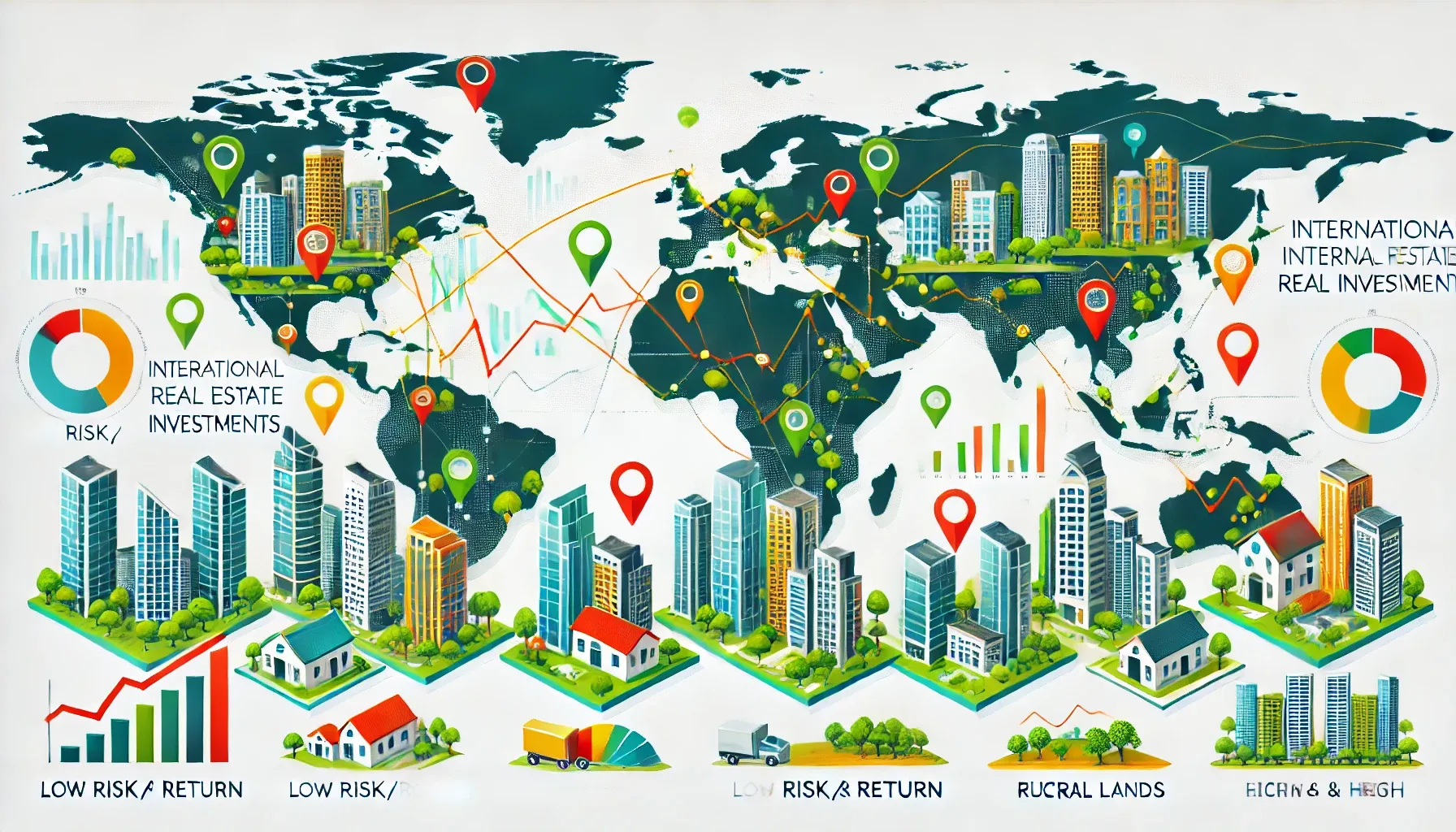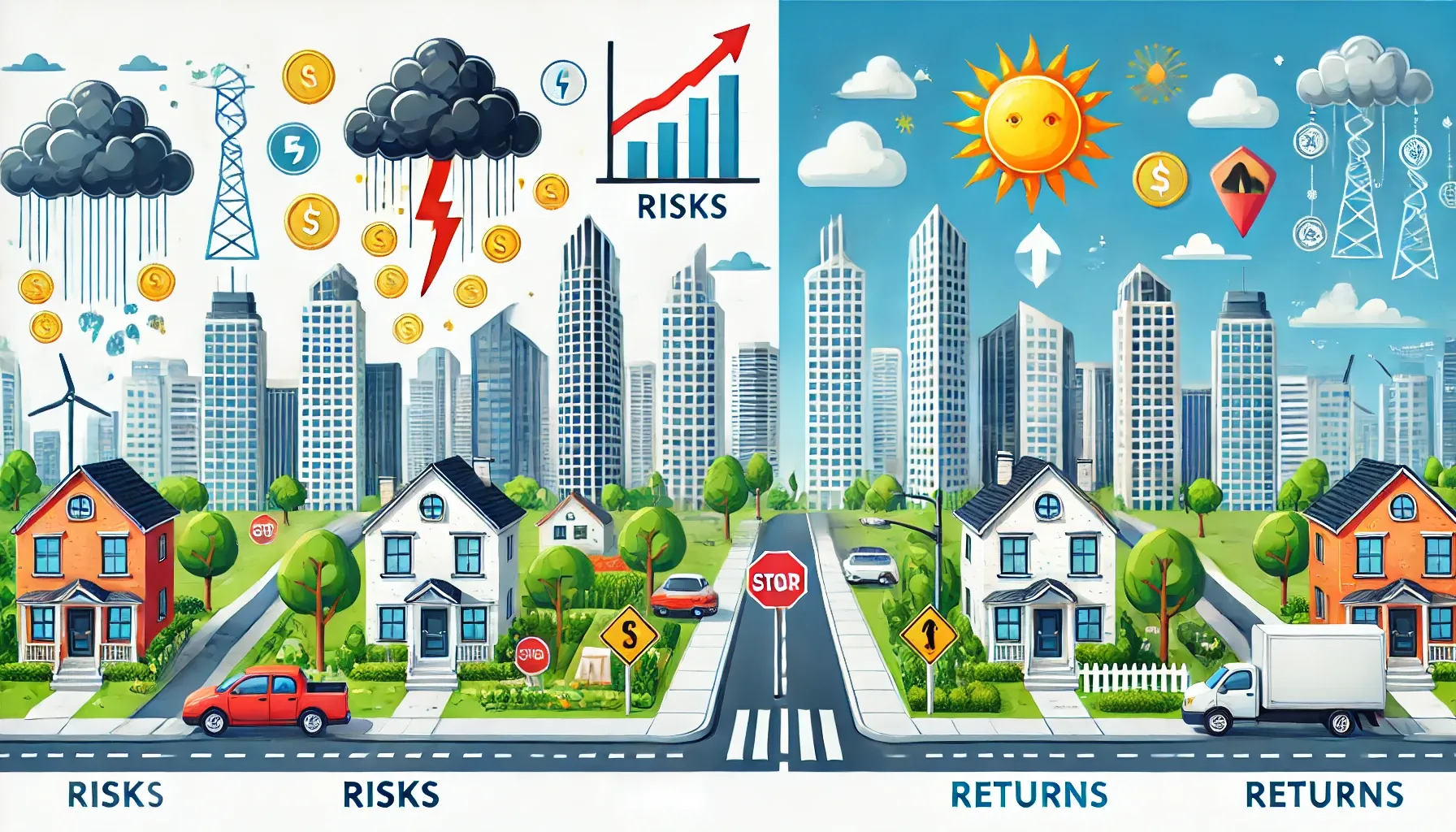Investing in foreign real estate: returns and risks

- Investing in foreignreal estate: stability and risks
- Investing in real estate: risk and return
Investments in foreign real estate: stability and risks
Among the various ways to increase capital, investing in foreign real estate is considered one of the most reliable. However, like in any other sector, there is a certain level of risk associated with the potential for high returns. Potential returns and risks when investing in foreign real estate are closely interconnected: the lower the risk, the lower the return, and vice versa. Assessing the risks of investing in a specific property is challenging, as risk cannot always be quantitatively measured.
Returns and risks in foreign investments
There is an optimal range of returns for investing in foreign real estate, which fluctuates between 4% and 7% in Europe. However, higher levels of returns are also possible, reaching from 8% to 12%. Risk can also be classified into several levels, depending on the type of investments in foreign real estate.
Specific risks and factors in real estate investing
In addition to general economic and political risks, there are specific factors characteristic of real estate investments, such as the features of the property, its location, lease duration, and asset liquidity.
Growing interest in alternative segments
In recent years, there has been a shift in investor interests towards less popular segments of foreign real estate, such as student dormitories, nursing homes, industrial properties, and even "exotic" assets like art galleries or cinemas. This is due to increased competition in the housing market and the availability of borrowed funds following the financial crisis of 2007-2008.
The increase in the share of unusual assets in the investment portfolio
The share of investments in commercial real estate, including movie theaters, bowling clubs and other "unusual" assets, has grown significantly, according to the CBRE report. "unusual" assets, has grown significantly according to the CBRE report, accounting for 14% of total investment in income-producing real estate in the UK.
The profitability of alternative assets
Investments in alternative real estate segments can offer returns ranging from 5% to 8%, depending on location and other factors. Thus, investing in unusual properties can be an attractive option for diversifying an investment portfolio and generating stable income.

Increasing the profitability of real estate
Property owners in various European countries often use strategies to ensure stable income. The ability to rent out apartments on a short-term basis can significantly increase profitability, but it also comes with certain risks.
Short-term leases with higher yields
For example, in the city of Budapest, the yield from long-term rentals is 3.5%, but the opportunity to provide housing to tourists for short periods can increase the net income to 7-10%.
Short-term rentals can be challenging due to the constant search for tenants and potential vacancies, which can ultimately reduce the overall return on investment. To mitigate these risks, investors may turn to professional management companies that can assist with the management and marketing of the property. With the right approach and management, the occupancy rate of the apartment can reach high levels.
Risks of investing in real estate
Some assets, such as logistics real estate, while capable of generating high income, have low liquidity. The volatility of prices and demand for such assets is linked to the economic situation and increases investment risks.
For example, in Russia, it is possible to find logistics centers with yields of up to 12.75%, but there is a significant risk of crisis situations. During the last crisis in Russia, retail trade volumes declined by 10%, which had a negative impact on freight transportation. Warehouse space has started to appear on the market in excess appearing on the market, indicating an increase in risk. Investors may face monopolies in the logistics sector and difficulties in managing such facilities. logistics and the complexities of managing such assets, making successful investment decisions more difficult.
Reducing risks in investing
To reduce risks, an investor can turn to professional management companies, although their services may be more expensive. With proper management and marketing of the property, the occupancy rate of the apartment can reach up to 90% during the season and not drop below 60%.
It's important to remember that any investment carries risks. However, with the right approach, you can reduce that risk and achieve stable income from real estate.
Introduction
Among potential investment objects, foreign real estate is considered a conservative asset; however, there are also opportunities for high-yield, yet risky, capital investment in this segment.
Returns and risks of investing in foreign real estate
As a rule, profitability and risks of real estate investments abroad are in direct correlation: the lower the risks, the lower the profitability of the object and vice versa. The lower the risks, the lower the yield of the object and vice versa.
29 September 2025
9 October 2024
9 October 2024
29 January 2025
29 January 2025

In addition to the economic or political risks that accompany investment activities in any market, real estate has a number of specific factors unique to this segment. These include, for example, the characteristics of the property, its location, the duration of the lease agreement with the tenant, and the liquidity of the asset.
Specific market segments
How it works:
- For many years, investor interest in the foreign real estate market has been focused on a simple and low-risk area, such as the residential sector.
- Over time, this led to competition among buyers for the most liquid properties and, as a result, to a decrease in the profitability of these properties, as too many investors wanted to rent out the acquired housing.
- After the 2007-2008 crisis, the factor of competition was joined by the low cost of borrowed capital.
- Together, these two trends have shifted buyers' interest towards a less explored segment of income-generating real estate — retirement homes, student apartments, industrial and warehouse spaces — as well as "exotic" commercial properties for investors, such as art galleries or cinemas.
- According to CBRE, from 2012 to 2015, the share of investments in properties such as cinemas, bowling alleys, exhibition centers, theme parks, and similar venues increased from 5% to 14% of the total investments in income-generating real estate in the UK.
What kind of returns you can get:
The yield of such properties varies depending on their location and averages between 5% and 8%. To achieve high returns, it will inevitably be necessary to engage not only in renting out the property but also in the related business.
Possible risks:
The risks of such investments are obvious: finding a tenant for a one-bedroom apartment, even on the outskirts of London, is incomparably easier than for an art gallery in the Mayfair area. In addition, specific types of real estate, such as entertainment or logistics properties, are tied to a corresponding type of business that may be less familiar to the investor than traditional residential or office rentals.
Objects in the province and suburbs
How it works:
Under certain conditions, offices and apartments can also have high returns associated with high risks. This is usually related to the location of such properties. For example, in the United States, in the largest cities with developed economies, offices are considered low-risk and low-yield assets. In the central business districts of New York, their yield averages 3.3-3.8%, in San Francisco - 3.0-4.0%, and in Seattle - 4.5-5.5%. Outside of prosperous locations, both yield and risks increase.
What kind of returns you can get:
Detroit has the highest office yields in the US, averaging 9.5-10.5%. Such Such a high level of this indicator is associated with the known risks of doing business in a bankrupt city. Similar spread is also observed on the periphery of economically successful locations. For example, in the suburbs of the already mentioned New Jersey, a suburb of New York, the average yield of office real estate reaches 7.0-7.5%.
Possible risks:
In depressed areas, as well as on the outskirts of large cities, there is a high risk of losing a tenant and not being able to find another one. This is usually due to the fact that the demand for rental properties in such places is lower than in the centers of successful cities. An investor can try to predict whether a certain location will become promising in terms of real estate acquisition. For example, the opening of a new metro station, the construction of a sports complex, or an educational institution can significantly increase the liquidity of local real estate. Unfortunately, such analysis will require expenses.
Short-term apartment rental
How it works:
Conservative investors often prefer long-term relationships with tenants or management companies because they are not looking for immediate profit, but are focused on the long-term preservation and growth of their investments in real estate.
Note:The article didn't have any URLs that needed to be removed.
Tags
Comment
Popular Posts
29 September 2025
393
9 October 2024
9942
9 October 2024
1487
29 January 2025
1530
Popular Offers

Subscribe to the newsletter from Hatamatata.com!
Subscribe to the newsletter from Hatamatata.com!
I agree to the processing of personal data and confidentiality rules of Hatamatata











